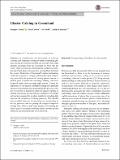Files in this item
Glacier calving in Greenland
Item metadata
| dc.contributor.author | Benn, Douglas I. | |
| dc.contributor.author | Cowton, Tom | |
| dc.contributor.author | Todd, Joe | |
| dc.contributor.author | Luckman, Adrian | |
| dc.date.accessioned | 2017-10-27T11:30:07Z | |
| dc.date.available | 2017-10-27T11:30:07Z | |
| dc.date.issued | 2017-12 | |
| dc.identifier | 251137586 | |
| dc.identifier | 56e7dd72-13c3-47f6-9728-1aec45e3edd5 | |
| dc.identifier | 85050379487 | |
| dc.identifier | 000461109800010 | |
| dc.identifier.citation | Benn , D I , Cowton , T , Todd , J & Luckman , A 2017 , ' Glacier calving in Greenland ' , Current Climate Change Reports , vol. 3 , no. 4 , pp. 282-290 . https://doi.org/10.1007/s40641-017-0070-1 | en |
| dc.identifier.issn | 2198-6061 | |
| dc.identifier.uri | https://hdl.handle.net/10023/11934 | |
| dc.description | The authors acknowledge funding from NERC NE/P011365/1 CALISMO (Calving Laws for Ice Sheet Models) | en |
| dc.description.abstract | In combination, the breakaway of icebergs (calving) and submarine melting at marineterminating glaciers account for between one third and one half of the mass annually discharged from the Greenland Ice Sheet into the ocean. These ice losses are increasing due to glacier acceleration and retreat, largely in response to increased heat flux from the oceans. Behaviour of Greenland's marine-terminating ('tidewater') glaciers is strongly influenced by fjord bathymetry, particularly the presence of 'pinning points' (narrow or shallow parts of fjords that encourage stability) and over-deepened basins (that encourage rapid retreat). Despite the importance of calving and submarine melting, and significant advances in monitoring and understanding key processes, it is not yet possible to predict the tidewater glacier response to climatic and oceanic forcing with any confidence. The simple calving laws required for ice sheet models do not adequately represent the complexity of calving processes. New detailed process models, however, are increasing our understanding of the key processes and are guiding the design of improved calving laws. There is thus some prospect of reaching the elusive goal of accurately predicting future tidewater glacier behaviour and associated rates of sea-level rise. | |
| dc.format.extent | 1384354 | |
| dc.language.iso | eng | |
| dc.relation.ispartof | Current Climate Change Reports | en |
| dc.subject | Iceberg calving | en |
| dc.subject | Greenland | en |
| dc.subject | Ice sheet models | en |
| dc.subject | G Geography (General) | en |
| dc.subject | GE Environmental Sciences | en |
| dc.subject | SDG 14 - Life Below Water | en |
| dc.subject.lcc | G1 | en |
| dc.subject.lcc | GE | en |
| dc.title | Glacier calving in Greenland | en |
| dc.type | Journal item | en |
| dc.contributor.sponsor | NERC | en |
| dc.contributor.institution | University of St Andrews. School of Geography & Sustainable Development | en |
| dc.contributor.institution | University of St Andrews. Bell-Edwards Geographic Data Institute | en |
| dc.identifier.doi | 10.1007/s40641-017-0070-1 | |
| dc.description.status | Peer reviewed | en |
| dc.date.embargoedUntil | 2017-10-26 | |
| dc.identifier.grantnumber | NE-P011365/1 | en |
This item appears in the following Collection(s)
Items in the St Andrews Research Repository are protected by copyright, with all rights reserved, unless otherwise indicated.

